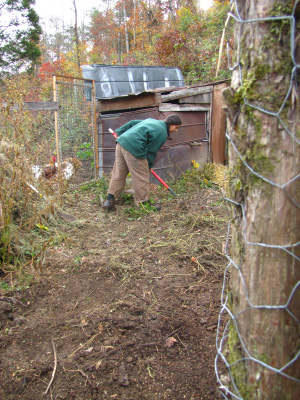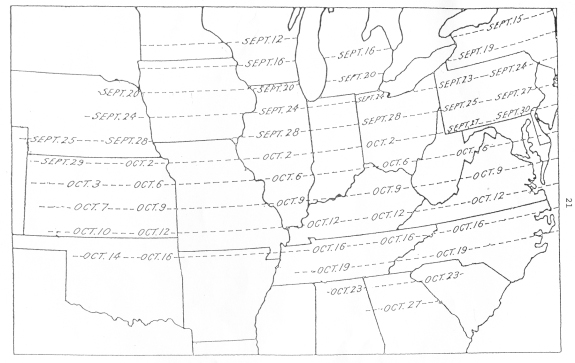
Winter wheat and the Hessian fly free date
 Although
I left laying pellets to tide our chickens over, they
clearly got a bit hungry while we were out of town for four days.
They had ignored
the buckwheat and beans before we left, but when we
returned I saw that our flock had eaten up every seed and scratched the
ground into a crumbly texture perfect for planting.
Although
I left laying pellets to tide our chickens over, they
clearly got a bit hungry while we were out of town for four days.
They had ignored
the buckwheat and beans before we left, but when we
returned I saw that our flock had eaten up every seed and scratched the
ground into a crumbly texture perfect for planting.
I shut the flock back
into the larger paddock and planted our winter wheat in the newly bare
ground. The combination of frost and chickens had broken down
even the stems of the previous crop so that I could easily rake the
wheat seeds into the soil.
I would have liked to
plant our wheat earlier, but it's very important to pay attention to
the Hessian fly free date when seeding wheat for grain. This
little insect burrows into leaves of young wheat before the frost, and
heavily infected fields will struggle so much that you get little or no
wheat harvest the next spring. By waiting until cold weather hits
to plant your wheat, you can bypass this pest. Each part of the
country has a Hessian fly free date after which it is safe to plant
your grain.

This map of Hessian fly
free dates from Purdue
University is the
best I've found, but I wonder about its accuracy here in the
mountains. I waited a few days longer than the map suggested,
until a frost made me confident that Hessian flies were long
gone. If all goes well, I should be able to graze
the chickens on the winter wheat in about a month, providing
a bit of winter greenery in their diets, then still get grain in spring
of 2011.
Want more in-depth information? Browse through our books.
Or explore more posts by date or by subject.
About us: Anna Hess and Mark Hamilton spent over a decade living self-sufficiently in the mountains of Virginia before moving north to start over from scratch in the foothills of Ohio. They've experimented with permaculture, no-till gardening, trailersteading, home-based microbusinesses and much more, writing about their adventures in both blogs and books.
Want to be notified when new comments are posted on this page? Click on the RSS button after you add a comment to subscribe to the comment feed, or simply check the box beside "email replies to me" while writing your comment.
- Remove comment
